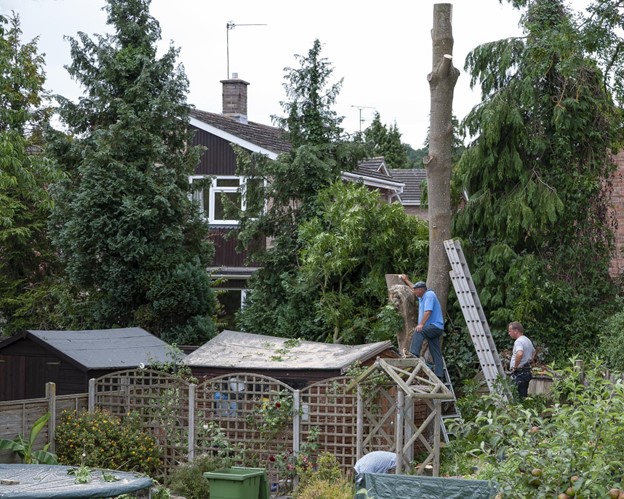Trees play a vital role in enhancing the beauty, value, and functionality of properties in Seattle. Proper year-round maintenance not only ensures healthy growth but also minimizes the risk of damage from storms and other environmental factors.
Seattle’s unique weather conditions make proactive tree care essential for property safety and long-term landscaping success. This guide provides a seasonal breakdown of tree care activities to help property owners keep their trees in top condition.
Spring: Preparing for Renewal
Spring is the season of growth and renewal, making it the ideal time to prepare trees for the active growing months ahead. After enduring winter’s harsh conditions, trees require focused attention to ensure they remain healthy and ready to thrive.
Key Activities:
- Tree Inspections: Examine trees for signs of winter damage, including broken branches, cracks, and early disease symptoms.
- Fertilization: Replenish nutrients in the soil with slow-release fertilizers to encourage robust growth.
- Selective Pruning: Remove dead or damaged branches to stimulate healthy new growth while maintaining the tree’s natural shape.
Considerations:
- Timing is critical in spring. Pruning too early may disrupt budding, while delaying trimming can allow pests or diseases to spread.
- Be cautious of over-pruning, as excessive trimming can hinder growth and weaken the tree.
By addressing winter damage and preparing for growth, spring tree care sets the foundation for a thriving landscape.
Summer: Maintaining Health and Safety
Seattle’s warm, dry summers can place stress on trees, making consistent care essential. This season is ideal for focusing on maintenance that supports health and safety while mitigating risks associated with heat and drought.
Key Activities:
- Deep Watering: Hydrate trees during dry spells by watering deeply and infrequently to encourage strong root systems.
- Mulching: Apply mulch around tree bases to conserve soil moisture, reduce weeds, and stabilize soil temperatures.
- Safety Trimming: Remove overhanging branches near buildings or utility lines to prevent damage from summer storms.
Considerations:
- Proper watering techniques are essential. Overwatering can lead to root rot, while underwatering can stress the tree and impede growth.
- Monitor trees for signs of heat stress, such as wilting leaves or sunscald, and address these issues promptly.
Summer maintenance focuses on supporting tree health while minimizing risks to your property.
Fall: Preparing for Dormancy
Fall is a critical time for tree care as growth slows and trees prepare for dormancy. This season provides an opportunity to make structural adjustments and address potential issues before winter storms arrive.
Key Activities:
- Structural Pruning: Thin out tree canopies to improve air circulation and reduce wind resistance. This is particularly important for areas prone to heavy fall storms.
- Leaf Management: Clear fallen leaves from around tree bases to prevent fungal diseases and keep the landscape tidy.
- Pest and Disease Prevention: Address late-season pests and diseases to avoid complications during dormancy.
Considerations:
- Pruning in fall helps prevent storm damage but should be performed carefully to avoid removing too much foliage.
- Fall is also an excellent time to assess tree stability and plan for any additional care needed before winter.
Proactive pruning and preparation during the fall help reduce risks and ensure trees are ready for the colder months ahead.
Winter: Protecting Trees from Harsh Conditions
Winter in Seattle often brings heavy rains, strong winds, and occasional snow, posing significant risks to trees. Protecting trees during this dormant season is essential to minimize damage and ensure healthy growth in spring.
Key Activities:
- Dormant Pruning: Focus on removing dead or hazardous branches while the tree is less active. This minimizes stress and reduces the risk of disease spread.
- Winter Protection: Use burlap wraps for young or vulnerable trees to shield them from freezing temperatures and harsh winds.
- Post-Storm Inspections: Check trees after storms for damage and address any issues promptly.
Considerations:
- Proactive care during winter can prevent costly damage to your property. Addressing weak branches before storms minimizes the likelihood of emergencies.
- Ensure proper drainage around trees to avoid root rot caused by waterlogging during heavy rains.
Winter tree care focuses on safeguarding trees from environmental stress while preparing for the upcoming growing season.
Why Tree Trimming Matters Year-Round
Tree trimming is an essential part of maintaining a healthy and safe landscape. While proper pruning promotes tree health and enhances appearance, neglecting this critical task can lead to safety hazards, especially during storms. For Seattle property owners, investing in professional tree trimming ensures well-maintained trees that enhance property value and reduce risks.
By balancing tree health with safety considerations, trimming keeps trees strong and resilient year-round. Additionally, incorporating seasonal adjustments allows trees to adapt to environmental changes, reducing the need for reactive measures.
Partner with Professionals for Sustainable Tree Care
Year-round tree care requires careful planning and expertise to address seasonal needs and environmental challenges effectively. Partnering with experienced arborists ensures your trees receive the care they need while protecting your property from risks.
For expert tree care and professional Seattle tree trimming services, consider Blooma Tree. Their team specializes in maintaining healthy, attractive trees tailored to the unique needs of Seattle properties.
With consistent care, your trees will remain an asset to your property, offering beauty, safety, and value throughout the year.










